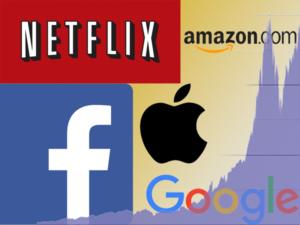
FAANGs for the Memories
Hong Kong, 30th June 2017
Technology stocks have been on a great ride recently, with so much written about them that the most fashionable even have their own acronyms, FAANG and BAT. For the first time ever, the world’s five biggest companies by market cap are all US tech stocks.
What does the make-up of the world’s top companies mean for investors? There is a handy Wikipedia page on the world’s largest companies at various periods in time, that is useful for viewing the investing fashions of the ages.
Some fashions, like the Hoxton fin, were mercifully fleeting. Others were like low-slung jeans, seemingly dragging on for decades against all expectations. And some are more like the hipster beard, still in full force but on an uncertain time-line.
The first photo of note is from 31 March 2000, the height of the TMT (technology, media and telecoms) bubble. The top global companies in order were: Microsoft, GE, NTT DoCoMo, Cisco, Wal-Mart, Intel, NTT, Exxon, Lucent, Deutsche Telecom. No less than 7 of the top 10 companies of the world were in the tech and telecoms, a number that remained unmatched (until very recently). History was not kind to several of these TMT stocks, and all bar Microsoft departed the top 10 over the subsequent 3 years.
Moving forward, the next wave of enthusiasm was for large oil and gas companies, a fashion which proved less fleeting and was prevalent from 2006 to 2011. This fashion was built on firmer foundations, with company profits being boosted by high and/or rising oil prices for most of the period (with the noted exception of the late 2008 collapse). At the end of 2007 there were 5 oil giants in the top 10 companies (1.PetroChina, 2.Exxon, 7.Gazprom, 9.Shell, 10.Sinopec), and there were 5 again present at the end of Q1 2011 (1.Exxon, 2.PetroChina, 5.Petrobras, 8.Shell, 9.Chevron). But this fashion too came to be overtaken by others, and then all but abandoned after the oil price collapse of 2014.
There have been clear fashions between countries as well. The Chinese stock market boom-bubble (and then bust) of 2007 elevated 4 Chinese companies into the top 10 (1.PetroChina, 4.China Mobile, 5.ICBC, 10.Sinopec). I remember this run very well, as everyone in the markets at the time was of a near-unanimous opinion: “Of course A-shares are in a bubble, but Beijing won’t let it burst until after the Olympics.” Not for the first or the last time, Chinese traders and speculators were surprised to find that the national team didn’t have a magic wand to set asset prices wherever they wanted. The crash, which started 9 months before the Olympics, had wiped over 50% off the index by the date of the opening ceremony.
Just as the fortunes of Chinese companies’ rankings changed, so too did those of the USA. By end-2009 there were only 4 USA companies in the hit list, and by end-2010 this had dwindled to just 3 (1.Exxon, 3.Apple, 5.Microsoft). This relative unpopularity would have been a good buying opportunity, as the S&P has considerably outperformed other major indices in common currency terms ever since. By the end of 2016 the tables were turned, and all 10 companies in the top flight hailed from the US. An unusual occurrence, and not entirely unrelated to the fact that US stocks are trading at more expensive valuations than those in Europe and other countries, as I mentioned in a recent article.
Looking at the most recent tables, the high concentration of US companies in 2015 and 2016 is only one feature. The latest list of top companies by market cap looks like this: Apple, Alphabet (Google), Microsoft, Amazon, Facebook, Berkshire Hathaway, Alibaba, Johnson & Johnson, Exxon, Tencent. 8 of the top 10 are still American. More strikingly the entire top 5, and 7 of the top 10 are from the tech sector – a level of popularity not seen since March 2000.
There are those who currently wear their jeans with two neat rips across the knees, drive a Tesla, and have just started working on their first dapp. They will probably like to ride with their FAANG positions a while longer while the fashion is still with us. But for those who are noble contrarians or long-term investors, the message in these observations is clear. To slightly amend Buffett’s famous phrase, “be fearful where others are greedy, and greedy where others are fearful”.
Receive updates by email




On Bubbles and Bitcoin
/0 Comments/in blog, Finance and economics, Financial Markets, Investing /by Andy+China’s Balancing Act
/0 Comments/in blog, Economics, Uncategorized /by Andy+FAANGs for the Memories
/0 Comments/in blog, Financial Markets /by Andy+